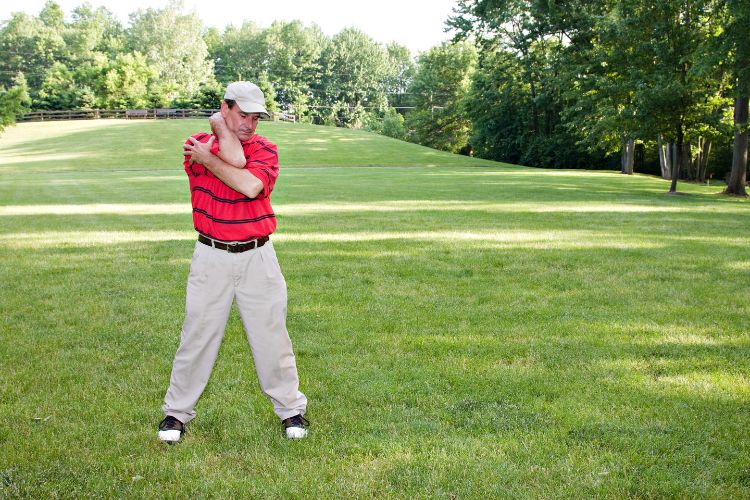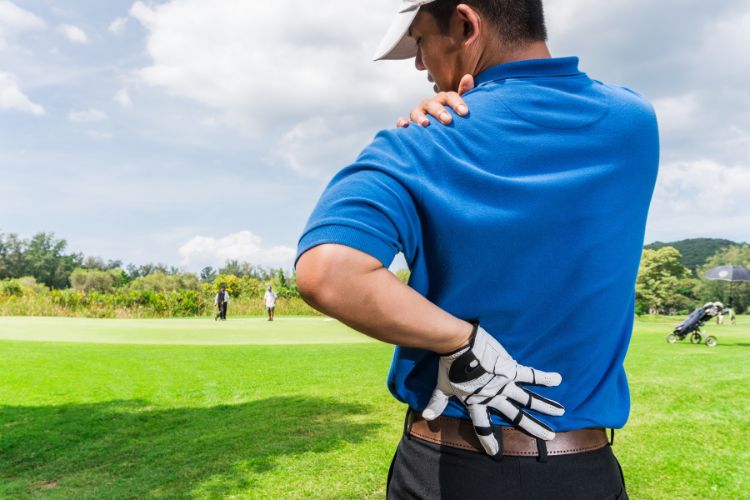Golf injuries are very common. The National Golf Foundation reports that over 36.9 million people play golf annually in America. The National Health Statistics Report indicates that 8.6 million people are injured in the process, and says that golf may cause more injuries than the sport of rugby.
One study estimated that as many as 18 to 54 percent of all golf injuries were back pain-related. That is just one of the many injuries that can be sustained in the sport of golfing.
Golf injury can be serious and problematic, and interfere with every area of your life. Learn more about the most common golf injuries here, and how to avoid them.
Common Golf Injuries
The British Journal of Sports Medicine reports from one study that as many as 66 percent of golfers will experience an injury if they are playing professionally. Approximately 31 percent of amateur golfers who played the sport within the last year reported a golf injury. Golf injuries are common.
The most common golf injuries include the following:
- Back injury
- Rotator cuff injury
- Golf elbow
- Wrist injury
- Knee pain and ankle pain injuries
When you are golfing, you are hunched and swinging most of the time, for a game that could last all morning and into the afternoon. For many golfers, more than one swing at the ball will only increase your risk of golf injury. This style of hunching is key to causing back injuries, which are the most common injury in the sport.
Rotator cuff injuries are also very common. The tendons around the shoulder along with the shoulder muscles are the most commonly used muscles during the game of golf. You could experience a rotator cuff injury to the shoulder when you are playing golf. You may also experience tendonitis of the shoulder muscles, which could be exacerbated if you do not stop playing the sport until you are healed.
This injury can be felt long after your game is over. You will feel weakness here and some pain. You will find it difficult to raise your arms above the head.
Golfer’s elbow or medial epicondylitis can cause problems in the arm. This injury is characterized by soreness and inflammation from the forearm to the top of your arm. The pain can be moderate, or severe if you leave it unchecked or without rest.
Wrist, knee, and ankle injury are also serious golf injuries and can occur during any sudden movement during the game. You can also experience these injuries with repetitive motion. The symptoms will appear as pain or warmth in the affected area.
You may notice your knee becomes swollen and warm, and the pain will not go away. The area in your forearm where your muscles go from your bones to your hand may feel burning and inflamed. When you do not get these muscles checked or X-rayed, you may suffer from a long-term injury that does not go away. With time, these ligaments and tendons can tear and require more intensive intervention.
Knee pain works the same. Left untreated you are going to make the problem worse. Golf is a low-impact sport, and can be very relaxing to have some drinks with some friends on the course every week. This is why many people do not let injury interfere with their choices. Still, as soon as you feel pain in your knees or wrists, have it checked out by a doctor before you head back to the course.
During a golf swing, your feet will move with the force of your swing. This is going to increase your risk of foot or ankle injury on the golf course. Every time you swing, your foot and ankle move. If you do not have the proper form, you could injure yourself. Walking an entire 18-hole course will also increase your risk of getting any or all of the most common injuries in golf.

Causes of Golf Injuries
The most common causes of golf injuries are not using the proper form, and also golfing when you are already injured. Golf can be a low-risk sport, but you are moving many large parts of your body all the time for several hours and can experience a repetitive motion injury as well. Whereas a game of basketball or football may only take a couple of hours, golf has you moving all day long. Learn how to play the game properly, and you will have a better shot at avoiding injury.
Practice having a light swing that packs a heavy swing. The harder you swing, the more pressure you put on the body parts that are making the swing. Swinging a golf ball can place stress on the body that you won’t be aware of until a serious injury occurs. If your muscle groups are already stressed, the injury could be very damaging.
Some sources indicate that as many as 80 percent of all golf injuries are caused by overuse and over-practice. These injuries are the result of poor flexibility and improper conditioning. Because your body will be working all day on the course, you’ll need to condition your muscle groups the way any other athlete would.
The remaining portion of golf injuries are caused by traumatic incidents. You might trip on the golf course, or experience a ground impact when swinging that places force and pressure on your shoulders, feet, or ankles. Accidents can happen in golf as well. Condition your body to withstand extended stress from golf, and you will reduce your risk of golf injury. Practice can make perfect, but too much practice can result in overuse injuries

Preventing Golf Injuries
They say an ounce of prevention offers up a pound of cure, and there is something to that. You can prevent golf injuries with a little bit of practice and prevention. Stay active and physically fit when you are not on the golf course. This helps you to strengthen your muscle groups and become fit overall when you are playing golf.
Add a cardiovascular routine to your daily living, even if it just includes a walk every day. Eat a healthy diet and maintain a healthy lifestyle so that you can walk the long courses on days when you can’t get a cart or caddy.
You also need to practice your golf swing to perfection. Do this for your game, but also for your overall health. A good golf swing puts much less stress on your body overall and will help you to become better at the game. With practice, your improved swings will also improve your overall strength, agility on the course, and your overall flexibility.
Warm up and stretch before every single game. This puts your body in the mindset of activity, and conditions your muscles to perform for you. Take a walk before you play the game, or simply go up and down a flight of stairs a few times. You have to stretch those muscles like any athlete would before any sport.
This will improve the speed of your club, and also prevent your muscles from wearing down during the course of a long game. Do these stretches and warm-ups even in the off-season when you are not playing golf.
Learn how to maintain good posture on and off the golf course. This will help you with your swing and reduce back injury and rotator cuff injuries. Hunching will not work well for you with your long-term vision of golf. Practice your form on the course, and maintain good posture off the course to keep that form in good motion.
Appropriate attire and equipment will also help reduce golf injury. Invest in a good pair of shoes that are both comfortable and fit right. You want shoes that can withstand any kind of weather. Cleats are preferred as they reduce the strain on the legs and ankles. Select clubs that are light in order to make it easier on your body over the course of the day.
Research the tools and steps you need to take to prevent golf injury. Know what exercises you can warm up with, and have the right equipment.
Treating Golf Injuries
Treating golf injuries comes first with realizing that you have an injury. There are some treatments that you can apply at home. If the pain worsens or lasts longer than a few days, talk to a doctor about having the injury looked at. These types of injuries are not injuries that are going to go away with time if you ignore them. Many golf injuries can be treated immediately, and with some rest and healing, can be healed permanently.
If you have a more serious injury such as a rotator cuff tear or golfer’s elbow, see a doctor. You will be given a physical exam and may get ultrasounds or X-rays that will help your doctor diagnose your injury accurately and completely. Severe injuries may require long-term physical therapy. This will pay off in time if you are hopeful to get back on the golf course.
These injuries may need to be treated with surgery. Many golf injuries will not.
The RICE method of rest, ice, compression, and elevation is effective when treating these injuries. The most important thing you can do after an injury is to rest the affected area, or, just rest. This can be hard for an avid golfer to do. Modify your activities in a way that will limit your use of this particular body part. It could take months of rest, but you will find it worth it if you can avoid permanent injury here.
Ice the affected area to reduce swelling and bring blood flow to your muscle groups. For leg and wrist pain, use a brace or tensor bandage to apply compression to the area. This alone may improve your overall symptoms and get you closer to healing completely.
Most importantly, see a doctor if you have a golfer injury and it is interfering with any other area of your life. Rest always, but call your doctor to have some tests run to rule out any serious injury. If you ignore the doctor, the injury will not go away. You can make a golf injury worse by doing nothing about it.
Take Charge of Your Golf Game
When you play golf, you run the risk of back injury, wrist injury, shoulder injury, and knee and ankle injury. Back injuries are the most common golf injury, although anything can happen on the course. Millions of Americans suffer from golf injuries every day. Prevent that with proper muscle conditioning and warmups, and having the right equipment and form.
When you can’t prevent it and injury happens, rest and take care of yourself before calling your doctor. Treat your golf injuries to ensure you can stay in the game and keep enjoying this important part of your life.
